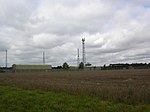Hoveton Little Broad
Norfolk Broads
Hoveton Little Broad, also known as Black Horse Broad, is a secluded broad of fairly open aspect, in the middle reaches of the River Bure between Hoveton and Horning, Norfolk, in The Norfolk Broads. Privately owned, it was the site of direct action in the mid-20th century by local people hoping to establish the right of free public access to all Broadland waterways.
Excerpt from the Wikipedia article Hoveton Little Broad (License: CC BY-SA 3.0, Authors).Hoveton Little Broad
Crabbetts Marsh, North Norfolk
Geographical coordinates (GPS) Address Nearby Places Show on map
Geographical coordinates (GPS)
| Latitude | Longitude |
|---|---|
| N 52.705555555556 ° | E 1.45 ° |
Address
Crabbetts Marsh
Crabbetts Marsh
NR12 8JP North Norfolk
England, United Kingdom
Open on Google Maps









